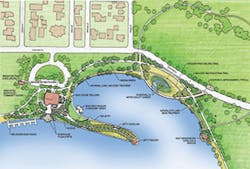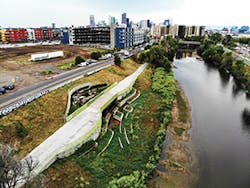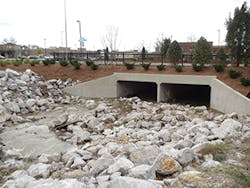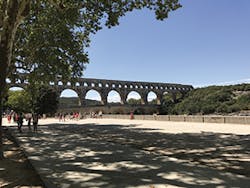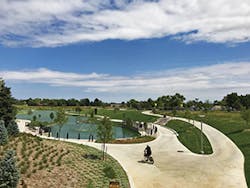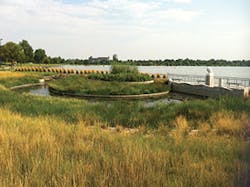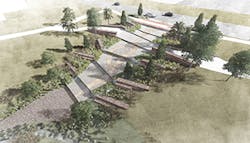Both the experiential and material qualities of the built environment matter greatly, and cities with a perceived high quality of urban life are thriving as a result of high-quality infrastructure. The time has come for us—as design professionals, civic leaders, and stewards of the urban environment—to respond to a shift in the way society values stormwater infrastructure and water altogether. Borrowing from an ancient ideology that streams and waterways are a resource for our communities that reaches far beyond basic conveyance and flood control functionality, drainage infrastructure must integrate essential characteristics and features that complement the desirable experiential qualities of the urban context. Rather than being “added value if budget allows,” our infrastructure should always incorporate multipurpose functionality and consider water-quality treatment, habitat enhancement, educational and recreational opportunities, and aesthetics. Our infrastructure should enhance the “place” and be integral—rather than interruptive—to the context, ultimately attracting people, raising property values, and creating a higher quality of life for our communities.
The objectives of presenting the following information are to impart a perspective on the value of integrating and improving the multifunctional aspects of drainage infrastructure implements, and to encourage urban planning, design, and construction practices for drainage infrastructure that complement and enhance the experiential and aesthetic qualities of our communities.
Figure 1. The River North Outfall in Denver provides integrated vegetation, experiential and recreational benefits, and water quality in a very large 1,200-cfs storm outfall.
So, Why Should We Be Concerned?
Many of the best urban open spaces are associated with natural drainage ways and are frequently on the receiving end of manmade structures that convey stormwater. When outfalling drainage infrastructure into multipurpose urban waterways, streams, and ponds, the details can really make or break the “place.”
The difference in the experiences afforded by urban waterways in which drainage infrastructure elements such as pipe and culvert outfalls, headwalls, “trickle” channels, erosion protection, and energy dissipation structures have been designed to enhance (or at least not detract from) the natural values of the corridor and celebrate water—versus those which have had little or no attention paid to aesthetics or experiential qualities—is significant. While great progress is being made within the realm of functional and beautiful conveyance channels, drop structures, and some water-quality facilities, less attention has been paid to creating context-sensitive, multifunctional, aesthetically pleasing features out of outfalls and inlet/outlet structures. These elements can be visually dominant in the landscape, and, with their associated conduits, headwalls, rundowns, and riprap armoring, can sometimes negatively impact the overarching design intent of high-profile redevelopment, or the rich historic urban fabric that often accommodates population and economic growth. Moreover, these elements often miss an important opportunity to celebrate water as humanity’s most important natural resource.
Who Cares? More People Than You Think!
Defining and Understanding Sensitive Contexts. In addition to the baby boomers and Gen X-ers out there, the younger and millennial generations appreciate and are especially drawn to quality—and they are voting with their feet. There are countless articles in the news and online touting the “most popular places to live” and move to, and all of these cities have one thing in common: a high perceived quality of life. William Frey of the Brookings Institution’s Metropolitan Policy Program notes that “the millennial generation, now 44% minority, is the most diverse adult generation in American history” and is “eclipsing the current size of the postwar baby boom generation” (Frey 2018). An article from Business Insider(2018) used data from the Brookings report to calculate the approximate number of millennials who moved to US cities from 2010 to 2015. That list is made up of many of the most progressive municipalities in the country for infrastructure and open space investment, including Seattle, Portland, San Antonio, Austin, Honolulu, Orlando, Springfield (MA), Charleston, and Denver. In short, cities with a perceived high quality of urban life are thriving and growing, and a poorly conceived infrastructure project could actually turn into a long-term liability for urban growth.
One of the major keys to successfully designing and implementing high-quality and attractive infrastructure is to understand sensitive contexts where this type of thinking is important. Some of the most important questions to ask in the early stages of analysis and design should help shape and influence design decisions that help make our infrastructure beautiful and durable—multifunctional and community-driven. Following is a list of some questions and considerations to help understand context:
Figure 2. Pipe and culvert outfalls are often implemented with little consideration for aesthetics or experiential value.
Will anyone see it?
- If it can be seen, it should be designed to be seen—as an aesthetically appealing and complementary piece of the urban fabric. Material and form decisions should be made with consideration to attractiveness over the long haul. Consider “fad” materials and style versus “timeless” design qualities.
(How) could people “experience” it?
- Will people want to—or could they—get close to it, touch it, and sit by it? If so, consider access and tactile characteristics—and provide seating or space for people to comfortably experience it. Additionally, the audial and visual characteristics of water are often an overlooked opportunity.
- What recreation integration is possible? Look for opportunities to integrate trails, overlooks, and open-space recreation experiences. Often, our stormwater infrastructure is located in places where nature and urban context collide; human nature compels people to seek out experiences that can provide a connection to nature.
- Will it be attractive for kids? If so, think of ways to create a safe and playful experience, either by actually providing opportunities to touch the water or some level of connection/interaction with nature.
Figure 3. Millennials make up a large percentage of the population in many US cities with a perceived high quality of urban life.
Figure 4. Interactive sculpture like this pelican, which invites visitors to turn an archimedes screw to move stormwater, can help inspire an understanding of water quality at this facility in Denver’s Sloan’s Lake Park.
Essential Multifunctional Value and Place-Making
Objectives for Experiential and Visual Impacts. There is a “new” paradigm for how we build our cities (that’s actually really old!). It takes inspiration from some of the masters of infrastructure dating back to the Egyptians and Romans who built things to last thousands of years, which were viewed as marvels of engineering and icons of the place—serving multiple purposes like moving water and people. This new paradigm indicates that we should be focused on infrastructure that we are proud of, that lasts, and that inspires future generations.
As such, our investments should help to create high-quality, livable communities—aesthetics, experience, and environment all matter greatly—and we can’t afford any more “throwaway” solutions.
Our infrastructure should always be designed and built to satisfy the basic functional and operational requirements identified by the governing bodies involved. Sound design and engineering should always serve as the foundation to satisfy drainage and flood control functionality; protect life, safety, and well-being; better the natural environment and ecology; employ new and proven technology; and utilize the best construction methods feasible. Yet with all that being said, the frequently used term “added value” implies that any value achieved beyond “the basics” is nonessential. Consider, however, that the way society values streams and water resources has evolved as a resource for our communities well beyond basic conveyance and flood control design. In this vein, the time has come for the design and implementation of our infrastructure to recognize and plan for multifunctional qualities as essential rather than as “added” value. As a primary objective, our infrastructure should incorporate multipurpose functionality and qualitative characteristics that help make a place that is attractive to people, betters life quality, and enhances natural ecology.
When considering an approach to creating infrastructure with successful place-making characteristics, the following criteria can be used:
- Complement and enhance the context. As described earlier, choosing ideas that fit in and enhance the current and future context is critical to the success of helping make the place.
- Support a greater vision. There are often several overlapping “vision” and “master” planning efforts that are being used to identify and characterize land uses and to guide the future development or evolution of an area. Early collaboration with the people and ideas associated with these efforts will help integrate infrastructure to support the vision rather than adding it on as an obtrusive appendage. An additional benefit to this type of collaboration is a better chance of buy-in and support for more progressive approaches. When we bring people along in design development, they are often more open to accepting new ideas and helping generate ideas for better operational sustainability.
- Improve quality of life. The term “quality of life” refers to the general feeling of well-being and contentment of people. Most commonly, we use the term to describe how people feel about their own physical health, family, economic conditions, and the environment, among other things. By providing infrastructure that enhances our surroundings and provides opportunities for enjoyment—either actively or passively—we have the ability to impact a community’s quality of life.
- Encourage economic development. The sheer attribute of making a place attractive to people implies potential for economic development associated with higher property values, more industry or commerce, and denser populations. The more our infrastructure supports a holistic vision of planning for successful growth and high quality of life, the more attractive our communities become—ultimately contributing to economic development in our cities. Simply put: if people want to be in a place, the place will be more valuable.
- Celebrate engineering. For many centuries, a celebration of civilization and engineering has been a way for societies to be progressive in problem-solving and “show off” their prowess in innovative technical solutions. Not only is it important to solve the most elemental problems like conveyance, stability, and construction feasibility, but we have the ability make our infrastructure sustainable and durable without sacrificing quality in our materials, aesthetics, and experiential qualities.
- Generate community pride. Just as societies have touted engineering proficiency over thousands of years, iconic landmarks, structures, and wonderful places have a spot in people’s hearts as a source of pride for where they live. People often associate their favorite places with special features and outstanding details, and they tend to protect these places from damage, vandalism, and undesirable uses by activating these areas and by creating a presence that discourages nefarious activity. By creating better places that are rooted in infrastructure, we encourage stewardship and pride in our communities.
Figure 5. The Pont du Gard is an ancient Roman aqueduct in southern France still revered for its architecture and beauty. Even after the Roman Empire collapsed and the aqueduct was no longer used to convey water, it remained largely intact due to the importance of its secondary function; it is still used as a bridge today, nearly 2,000 years later.
How Do We Get This Done?
Creativity. A collaborative engineering and landscape architectural process exploits opportunities and results in creative solutions.
To succeed in using infrastructure to create better places, we must first have a vision for the place. If we understand the opportunities, goals, and objectives, infrastructure can support the vision. Secondly, we need to include the right people. Successful projects always consider different perspectives and expertise, which means that the client, engineers, landscape architects, building architects, contractors, and technical reviewers must all be involved early and often in the planning and design process.
To illustrate an approach to avoiding technically dominant designs, consider the left brain/right brain theory for functionality in design. The theory hypothesizes that a “left brain dominant” person is more logical or analytical (engineer), and a “right brain dominant” person is more intuitive or creative (architect). While designs that are 100% independently developed by either engineers or architects could meet basic project goals, they are often hindered from reaching their full potential because they weren’t developed using both “sides” of the brain. Improving design team diversity is the simplest and most effective way to avoid technically dominant designs, but it goes beyond simply adding a landscape architect to an engineering design team or vice-versa. The collaborative process between engineer, architect, and owner needs to be initiated at the very beginning of a project prior to any technical calculations being performed, and it should focus on project visioning and goal establishment before getting into the details. This is where qualitative criteria are introduced, and creative, unfettered design concepts begin to take form—being guided by both sides of the brain. Although this process can be challenging for some technical consultants and engineers who are not accustomed to the approach, in time the process will become more comfortable and even energizing. Most importantly, the heightened post-project benefits for the community and client will make it worthwhile.
Figure 6. A 102-inch storm pipe outfall was integrated into new park features and the renovated pond at Aurora’s City Center Park.
Courage. Try new things, challenge status quo, and accept some risk with design considerations and technical details.
Too often in stormwater management design, the technical or engineered aspects can take on a dominant role as a result of prioritizing precise function and technical criteria, public safety, and budget constraints. All three items are paramount and should never be ignored; however, because it is relatively easy to precisely quantify these metrics in a design, technical consultants and engineers may lose sight of other qualitative standards by which a design should be evaluated. To successfully push design, we sometimes have to force ourselves to take risks and try new things. Although we need not abandon proven and successful approaches, to be progressive, we must challenge the status quo and evolve design to avoid stagnation.
An easy way to illustrate this idea is by using a hypothetical case study to evaluate a simple storm sewer conveyance system design. Belowground closed (piped) systems with standard headwall and rundown structures are one of the most proven and effective ways to collect and convey stormwater flows, and most of these designs would rank very highly for function, public safety, and budgetary value. Piped and hard-structure systems are often perceived to be “easier” because they readily meet standard quantitative criteria, which simplifies the review and approval process. Only when more qualitative criteria are introduced—such as the potential peak flow reduction due to infiltration, water-quality treatment, long-term maintenance costs, aesthetics, educational/recreational opportunities, passive irrigation potential, and the opportunities to support and enhance other public infrastructure—does one begin to understand the benefits of a surface-located open conveyance system with creative interfaces for people. By comparison, an open system could rank as high (for collection and conveyance function, public safety, and budgetary value) as a piped system, but could add essential experiential and qualitative values to the project—which not only make the project better, but ultimately provide significantly higher overall value when maintenance, property values, and urban growth are considered.
Figure 7. The water-quality feature at Denver’s Sloan’s Lake Marina was designed with interactive art, trails, and an overlook.
Commitment. To get progressive infrastructure approved, keep an open mind and realize that exceptional design and return on investment take time.
Embarking on designs that are less standard in content can be uncomfortable and unsettling for some; however, building energy around enhancement opportunities that would otherwise not be achieved with a more traditional design is key to maintaining project momentum and getting buy-in from clients. While it’s important to be empathetic with those being pushed beyond their comfort zones, it is becoming costly for communities to continue to “play it safe” with standard infrastructure improvements. Taking a progressive approach to design may result in slightly higher design costs than the typical approach (minimal impacts to overall project costs); however, it does not necessarily always translate into higher construction costs—and can even save money and raise tax revenues over the long haul. Ultimately, value is appraised by more metrics than simple conveyance function and safety. In the new paradigm of stormwater infrastructure design, we are realizing that (perceived) easy solutions are not always the best solutions. This thinking is supported by a positive trend in the industry for the removal and replacement of aging closed (piped) systems that use standard headwall and rundown structures with open systems that are saving money and providing multiple benefits in drainage function, ecological enhancements, and in experiential/aesthetic qualities that make a place memorable and enjoyable. Drawing attention to these types of examples and the metrics by which they succeed is important for maintaining positive project energy and focus. For instance, on a typical belowground closed system, a large portion of the budget could be spent on relocating conflicting utilities, dewatering, environmental costs, and other expenses related to waterway construction; thus, it is beneficial to quantify those anticipated costs and illustrate how budget could be repurposed for nicer-looking structures, better vegetation and irrigation, integrated trails and recreational amenities, lighting and furnishings, or other multifunctional elements that not only support conveyance function but also add value to the community on many other levels.
Figure 8. This rendering of the new spillway design at 38th and Holly in Denver illustrates how custom gabions, enhanced paving, and integrated landscape plantings will make the feature an aesthetically pleasing addition to the neighborhood.
Case Studies
The following recent Denver area case studies illustrate custom-designed drainage features that challenge the status quo. Some blend in inconspicuously, and others stand out as attractive and interactive design features.
Aurora’s Metro Center Station and City Center Park. Spurred by frequent flooding near the development of a new light-rail station and TOD, this project addresses pedestrian connectivity and flood reduction drainage improvements at Aurora’s municipal campus. When faced with outfalling a new 102-inch storm pipe into a high-profile park, designers sought to harmoniously integrate the large outlet structure into new park features and improvements, overlooks and terraces, and a renovated pond.
Sloan’s Lake Marina Outfall and Water-Quality Garden. This hybrid detention basin/sediment forebay structure is poised on the banks of a popular recreational lake, illustrating how stormwater infrastructure can be designed to complement and enhance park areas.
38th and Holly Detention Facility. This City of Denver flood control and detention facility was redesigned to remove flood waters from adjacent roads and structures, redirecting flows over a new interactive bypass spillway and adding landscape improvements and an integrated path, overlook, and landscape features that are passively irrigated by nuisance flows.
Figure 9. The River North Outfall in Denver is an example of how a very large piece of drainage infrastructure can be artfully integrated into the context, taking into account future development conditions and recreational opportunities with technical conveyance and bank stabilization on the South Platte River.
The River North 33rd Outfall. A large storm sewer outfall for an 8- by 11-foot (about 1,200 cubic feet per second) box culvert in Denver’s rapidly redeveloping RiNo neighborhood called for a dynamic, custom design because of its high visibility along the South Platte River Greenway, adjacency to a new park and promenade, and proximity to several high-profile redevelopment projects. During the early stages of the project, several design concepts were vetted among the team, and while evaluation for technical feasibility was important for all options, it was not the only driving force for design. The design team recognized that nearly all options could be engineered, but achieving other qualitative goals on top of the functional requirements was critical to the successful integration of the outfall into the community. To maintain project momentum, cost estimates were routinely updated and conceptual comparisons to more traditional designs were also made. Extensive budget that would have been spent on construction dewatering and belowground sheet pile cutoff walls in a traditional design was instead allocated to architectural elements, integrated planting, and enhanced trail infrastructure, which better serves the community on other levels.
References
Abadi, Mark. 2018. “The 10 US Cities Where Millennials Can’t Wait to Move.” Business Insider, February 16, 2018. www.businessinsider.com/cities-millennials-are-moving-to-2018-2.
Frey, William H. 2018. “The Millennial Generation: A Demographic Bridge to America’s Diverse Future.” The Brookings Institution. www.brookings.edu/research/millennials/.
